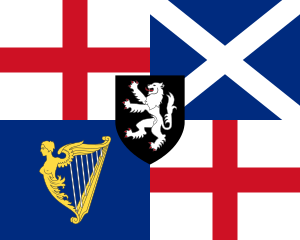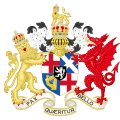Lord Protector facts for kids

A Lord Protector was a special title used in British history. It usually meant the person in charge of the country, like a head of state. Sometimes, it was also given to someone who ruled for a king or queen who couldn't, like when they were too young or away. This person was called a regent.
Contents
Early Lords Protector: Ruling for a King or Queen
The title "Lord Protector" was first used for important princes or nobles. They acted as a protector and defender of the kingdom. They also led a council that governed the country. This happened when the real monarch couldn't rule. Reasons included being too young, away on a Crusade, or being ill.
Here are some famous examples in England:
- John, Duke of Bedford, and Humphrey, Duke of Gloucester, were joint Lords Protector. They ruled for Henry VI from 1422 to 1429. Henry was a child at the time.
- Richard Plantagenet, Duke of York, was Lord Protector three times for Henry VI. This happened between 1454 and 1460.
- Richard, Duke of Gloucester, was "Lord Protector of the Realm" in 1483. He ruled during the short time of Edward V. Edward was one of the Princes in the Tower. Richard later became King Richard III.
- Edward Seymour, Duke of Somerset, was Lord Protector from 1547 to 1549. He ruled when Edward VI was a young king.
In Scotland, there were also similar roles:
- John Stewart, Duke of Albany, was "Governor and Protector of the Realm." He ruled for James V of Scotland from 1515 to 1524.
- James Hamilton, Duke of Châtellerault, was "Governor and Protector of the Kingdom." He ruled for Mary, Queen of Scots from 1543 to 1554.
The Cromwellian Era: A New Kind of Leader
Quick facts for kids Lord Protector of England, Scotland and Ireland |
|
|---|---|

|
|
| Style | His Highness |
| Residence | Palace of Whitehall |
| Appointer | Hereditary |
| Formation | 16 December 1653 |
| First holder | Oliver Cromwell |
| Final holder | Richard Cromwell |
| Abolished | 25 May 1659 |
The title Lord Protector of the Commonwealth of England, Scotland and Ireland was used during a special time in British history. This period is called the Commonwealth or the Interregnum. It happened after the English Civil War, when there was no king.
Oliver Cromwell held this title from December 1653 to September 1658. His son, Richard Cromwell, took over from September 1658 to May 1659. This time is known as The Protectorate.
The first republican constitution, called the Instrument of Government (1653), said:
Oliver Cromwell, the main general of the forces of England, Scotland and Ireland, is now declared Lord Protector of the Commonwealth of England, Scotland and Ireland, for his whole life.
A later constitution in 1657, the Humble Petition and Advice, allowed the Lord Protector to choose his next leader. Oliver Cromwell chose his oldest living son, Richard. Richard was not very experienced in politics. This way of choosing a leader was similar to how kings passed down their power. The Lord Protector even had some powers like a king, such as giving out knighthoods.
Richard Cromwell became Lord Protector after his father died in September 1658. But he only held the position for eight months. He resigned in May 1659. After him, the Commonwealth ruled again for a short time. Then, the monarchy was brought back in May 1660, with Charles II becoming king. This event is called the Restoration.
Lords Protector (1653–1659)
| Lord Protector | Lifespan | Term began | Term ended |
|---|---|---|---|
 Oliver Cromwell Old Ironsides |
25 April 1599 – 3 September 1658 (aged 59) |
16 December 1653 | 3 September 1658 (Died) |
 Richard Cromwell Tumbledown Dick |
4 October 1626 – 12 July 1712 (aged 85) |
3 September 1658 | 25 May 1659 (Resigned) |
After Cromwell: The Title's Decline
Since the monarchy was restored in 1660, the title "Lord Protector" has not been used in the same ways. When George, Prince of Wales, became regent in 1811, he was called "His Royal Highness the Prince Regent". He had the same powers as a Lord Protector. However, the title "Lord Protector" had become linked with the time when there was no king, so it was not used again.
Protector of the Church
The term 'Lord Protector' also meant someone who protected the worldly interests of a part of the church. This was like a king or noble acting as a guardian for the church's non-religious matters.
In Fiction: Lords Protector in Stories
The title "Lord Protector" has appeared in books and TV shows:
- In the novel The Last Man by Mary Shelley, Britain becomes a republic. Its elected leader is called the Lord Protector.
- In the 1987 TV show The New Statesman, a character named Alan B'Stard briefly thinks about using the title Lord Protector.
- In the 2020 film Wolfwalkers, the main bad guy is called the Lord Protector.
See also
 In Spanish: Lord protector para niños
In Spanish: Lord protector para niños


